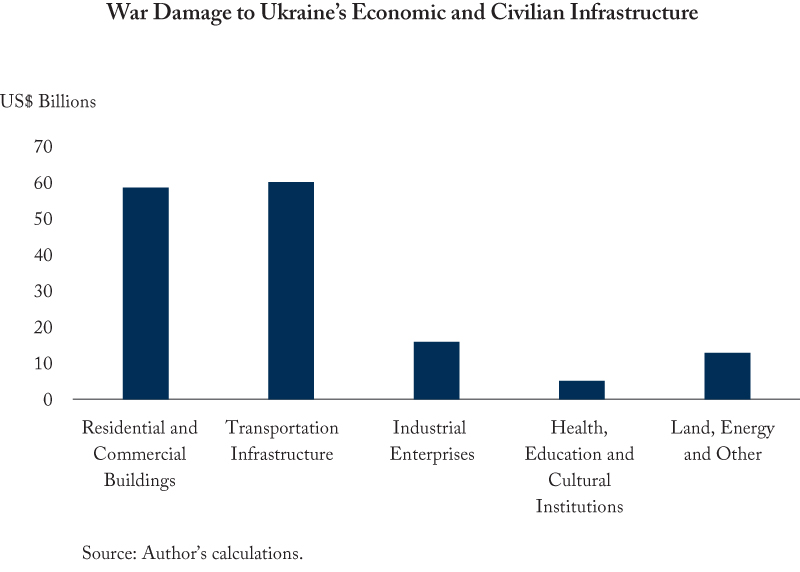From: Dan Ciuriak
To: Canadians Concerned about Ukraine
Date: August 10, 2022
Re: Counting the Cost (I)
In this first Intelligence Memo based on my new C.D. Howe Institute paper, we count the economic cost of the physical damage to Ukraine’s economic and civilian infrastructure of Vladimir Putin’s invasion of Ukraine, now approaching six months old.
As of the end of July, or at 22 weeks since the start of the invasion, the damage done in Ukraine was on the order of US$180 billion. With an unrelenting rain of artillery shells and missiles on Ukrainian cities, including on civilians well away from the actual front lines, this total has grown inexorably. The final tally, regardless of the war’s outcome, will easily exceed US$200 billion.
The physical damage to Ukraine so far comes from:
- Destruction of Ukrainian buildings and transportation infrastructure – this is the largest material cost so far of around $140 billion. Entire cities in the direct path of the Russian army, such as Mariupol, Severodonetsk, and Lychyansk, have been largely reduced to rubble while missile attacks continue to hit cities across Ukraine daily.
- Destruction of industrial enterprises, epitomized by the reduction to rubble of the industrial city of Mariupol through weeks of shelling and missile attacks, in particular Mariupol’s now famous Azovstal steel producer. An interim estimate is $19 billion.
- Destruction of hospitals, schools, and cultural centres: $6.2 billion.
- Destruction of Ukraine’s food and energy production and distribution system: $16 billion.
The estimated total amount of destruction is now on the order of some four-fifths of Ukraine’s annual pre-war gross domestic product (GDP). Given that on average, a country’s stock of assets is on the order of six times its GDP, this places the destruction at about one-seventh of Ukraine’s pre-war assets. This is a realistic order of magnitude for the level of destruction given the breadth, intensity and length of the assault and consistent with what was seen in Chechnya and Syria where Putin’s forces were unleashed without restraint.
These costs could soar given the risks to the Zaporizhzhia Nuclear Power Plant, Europe’s largest, from the Russian military, which has mined the plant and threatened to destroy it.
Ultimately, for both humanitarian and geopolitical reasons, the international community will shoulder a good part of the costs of rebuilding. Canada, along with its international partners, can help contain these and other costs by supporting Ukraine’s ability to resist Russian advance and defend against its missile attacks on cities behind the front lines while maintaining the economic sanctions that a recent systematic evaluation indicates is working to impair Russia’s war economy, which depends heavily on Western-made microelectronics to operate the high-tech weapons and communications systems it has used in Ukraine, according to the UK’s Royal United Services Institute.

In further Intelligence Memos, we’ll show how these costs are just the beginning of tallying the overall costs of Russia’s “special military operation.”
Dan Ciuriak is Fellow-in-Residence with the C.D. Howe Institute, Senior Fellow with the Centre for International Governance Innovation, and Director and Principal, Ciuriak Consulting Inc.
To send a comment or leave feedback, email us at blog@cdhowe.org.
The views expressed here are those of the author. The C.D. Howe Institute does not take corporate positions on policy matters.





